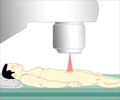An effective and specific imaging method of detecting both primary and metastatic lesions is thus of critical importance to manage patients with prostate cancer.

‘The new agent - a PET radiotracer - is both safe and effective to help find prostate cancer in both early and advanced stages and plan treatment.’





The new agent is a gallium-68 (Ga-68)-labeled peptide BBN-RGD agent
that targets both gastrin-releasing peptide receptor (GRPR) and integrin
αvβ3. Dual-receptor targeting provides advantages over single-receptor
targeting by allowing tumor contrast when either or both receptor types
are expressed, improving binding affinity and increasing the number of
effective receptors. "Although treatable at the early stage, prostate cancer is prone to metastasis," explain the team of authors, led by Xiaoyuan Chen, senior investigator, Laboratory of Molecular Imaging and Nanomedicine at the U.S. National Institute of Biomedical Imaging and Bioengineering. "An effective and specific imaging method of detecting both primary and metastatic lesions is thus of critical importance to manage patients with prostate cancer."
This study included 13 patients with prostate cancer (four newly diagnosed and nine post-therapy) and five healthy volunteers. Ga-68-BBN-RGD PET/CT detected 20 bone lesions in seven patients either with primary prostate cancer or after radical prostatectomy. The patients with bone metastases did not necessarily have an elevated prostate specific antigen level.
"This result is better than bone scanning with MDP," Chen notes, referring to the most common radiotracer used today. "MDP bone scans are sensitive but lack specificity because localized skeletal accumulation of Tc-99m-MDP can also be observed in the case of trauma and infection." No adverse side effects were found during the whole procedure and two-week follow-up, demonstrating the safety of Ga-68-BBN-RGD.
"Compounds capable of targeting more than one biomarker have the ability of binding to both early and metastatic stages of prostate cancer, creating the possibility for a more prompt and accurate diagnostic profile for both primary and the metastatic tumors," explains Chen.
Advertisement
Authors of the article "Clinical translation of a dual integrin αvβ3 and GRPR targeting PET radiotracer 68Ga-BBN-RGD" include Jingjing Zhang, Fang Li, Shaobo Yan, Li Huo, Libo Chen, Xinrong Fan, Weigang Yan, Zhiyuan Li and Zhaohui Zhu, Peking Union Medical College Hospital, Chinese Academy of Medical Sciences and Peking Union Medical College, Beijing, China; Gang Niu, Lixin Lang, Xuefeng Yan, and Xiaoyuan Chen, National Institute of Biomedical Imaging and Bioengineering (NIBIB), National Institutes of Health, Bethesda, Maryland.
Advertisement



![Prostate Specific Antigen [PSA] & Prostate Cancer Diagnosis Prostate Specific Antigen [PSA] & Prostate Cancer Diagnosis](https://images.medindia.net/patientinfo/120_100/prostate-specific-antigen.jpg)










